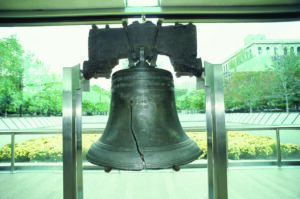(Editor’s note: DeeDee Wood is the owner of Black Cat Curiosities, an online antiques research and sales venue.)
The month of July brings about images of enduring freedom and American symbolism, with the celebration of Independence Day on July 4.
One of the most enduring symbols of freedom is the Liberty Bell, with its famous crack and iconic phrase, “Proclaim Liberty Throughout All the Land Unto All the Inhabitants thereof,” the bell has a rich, interesting history in the city of brotherly love.
The Liberty Bell was once called the State House Bell, and was originally placed in Pennsylvania State House steeple (now renamed as Independence Hall.)
The bell was originally commissioned in 1752 by the Pennsylvania Provincial Assembly, and poured by a foundry in London.
After cracking when it first arrived in Philadelphia, it was recast twice by two local founders named John Pass and John Stow, who now have their name on the bell, as a nod to their hard work to restore the bell.
The iconic phrase on the bell, “Proclaim Liberty Throughout All the Land Unto All the Inhabitants therof” is a reference from the Bible, from the Book of Leviticus, symbolizing religious and political freedom in Philadelphia, and a comparative relation to an old story about Israelites returning to their land after 50 years of enslavement. In this same vein, the bell was a symbol and inspiration of freedom for abolitionists before and during the Civil War area, partly due to this inscription of freedom. 
During this time period, these abolitionists for freedom renamed it the “Liberty Bell.”
When the bell was first in use in the State House steeple, it was used to gather and summon the legislative body into session in the structure, inform the public of meeting times, proclaim certain announcements were about to be made, and other announcements that need official ringing.
Legend has it, that the Liberty Bell was rung to announce the vote for Independence of July 4, 1776, but, bells were not rung on this day in relation to the vote.
It is possible, however, that it was one of the bells rung on July 8th, just a few days later, to mark the reading of the Declaration of Independence.
The bell also rang for the deaths of famous statesmen and Presidents, such as George Washington, Alexander Hamilton, Thomas Jefferson and Benjamin Franklin.
The bell went on a few “road trips” during its early years, including it being moved in 1777 from Philadelphia to Allentown, Pennsylvania, in fear the British would melt it to make cannons.
It was returned the following year. It also went on a “tour” around the United States in 1915, but was returned to Philadelphia, due to concerns about damage, people taking bits of scrapes off of it for souvenirs, and the crack that was become more apparent in the bell.
The crack in the bell forming has many theories.
Some say it cracked during the ringing of the death of Chief Justice John Marshall in 1835, and others say it cracked on the very first ring it was given, back in 1752, and this was the reason it had to be recast.
Whatever the truth about the crack, in 1846, the bell was rung to celebrate President’s Day and George Washington’s birthday, and it stopped ringing on this occasion due to the deepening of the crack, and has not been able to ring since this incident.
The sound has been recreated in some modern computer models to signify the deep, rich ring.
The Liberty Bell was moved from Independence Hall to a larger “Liberty Bell Center” on Independence Mall in 1976, when it was given to the National Park Service by the city of Philadelphia.
It was moved mainly due to interest, popularity and icon status, giving it a better viewing access point.
The bell has been featured on many stamps, coins, advertisements and American symbolism for years, a symbol and tribute to freedom and independence from tyranny.



